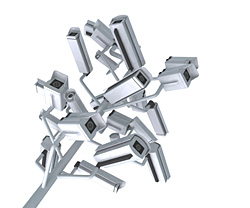china
Placeholder
From wikipedia:
The art students who created the [Goddess of Democracy] statue wrote a declaration that said in part:
“At this grim moment, what we need most is to remain calm and united in a single purpose. We need a powerful cementing force to strengthen our resolve: That is the Goddess of Democracy. Democracy… You are the symbol of every student in the Square, of the hearts of millions of people.… Today, here in the People’s Square, the people’s Goddess stands tall and announces to the whole world: A consciousness of democracy has awakened among the Chinese people! The new era has begun! …
The statue of the Goddess of Democracy is made of plaster, and of course cannot stand here forever. But as the symbol of the people’s hearts, she is divine and inviolate. Let those who would sully her beware: the people will not permit this! …
On the day when real democracy and freedom come to China, we must erect another Goddess of Democracy here in the Square, monumental, towering, and permanent. We have strong faith that that day will come at last. We have still another hope: Chinese people, arise! Erect the statue of the Goddess of Democracy in your millions of hearts! Long live the people! Long live freedom! Long live democracy!”
The document was signed by the eight art academies that sponsored the creation of the statue: The Central Academies of Fine Arts, Arts and Crafts, Drama, and Music; the Beijing Film Academy; the Beijing Dance Academy; the Academy of Chines Local Stage Arts; and the Academy of Traditional Music.
The entire statement was written on a long banner placed near the statue, and was read in its entirety by a female student “with a good Mandarin accent” from the Broadcasting Academy.
20 Years On
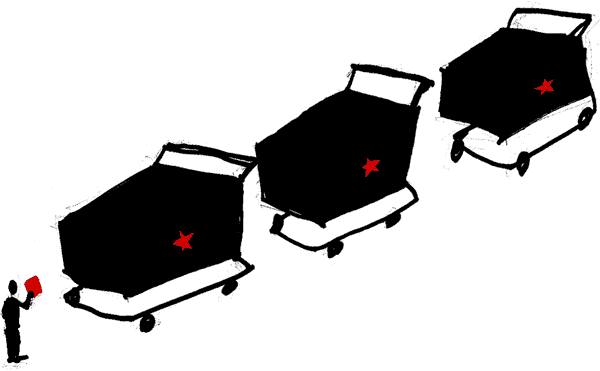
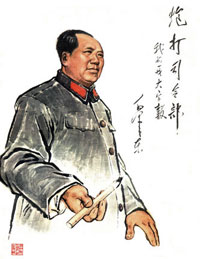 “During the twentieth century, the social and political uses of calligraphy have been radically changed. Calligraphy is no longer an art associated primarily with the traditional scholarly elite. Not only has calligraphy been employed as a tool of revolution, but it has become a popular amateur art practiced by people of all walks of life, and artists have found ways to use it to challenge traditions rather than perpetuate them.…
“During the twentieth century, the social and political uses of calligraphy have been radically changed. Calligraphy is no longer an art associated primarily with the traditional scholarly elite. Not only has calligraphy been employed as a tool of revolution, but it has become a popular amateur art practiced by people of all walks of life, and artists have found ways to use it to challenge traditions rather than perpetuate them.…Even if block-like calligraphy had revolutionary overtones, Mao and other leading revolutionaries wrote in styles much closer to traditional calligraphy. Moreover, even after most people took up writing with pencils and ball-point pens, leading party members continued to do calligraphy with traditional brushes. They would give away pieces of their calligraphy and allowed their calligraphy to be widely displayed.… Mao Zedong’s calligraphy was more widely displayed than that of any other leader.”
Red Crystal
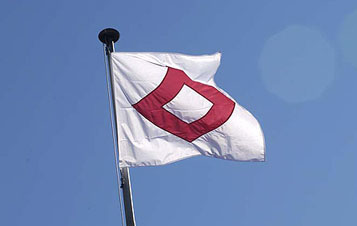
The Geneva Conventions were amended today to address a question of branding.
The Third Additional Protocol to the 1949 Geneva Conventions entered into force today, completing the process of establishing an additional emblem for use by Governments and the International Red Cross and Red Crescent Movement. So far, 84 States have signed the Third Protocol and nine States have ratified it.
The red crystal symbol is now officially recognized under international law as offering equal protection as the red cross and the red crescent when marking: “military medical personnel, establishments and transport; the staff of national societies; staff, vehicles and structures of the ICRC and the International Federation.”
From the ICRC Factsheet:
“The new symbol is intended to facilitate access by humanitarian workers to victims of conflict and other crises, in particular in situations where the use of an emblem devoid of any perceived political, religious, cultural and connotations may be an advantage.”
See the full text of the Additional Protocol. (Thanks, Romualdo!)




The Wikipedia article on the Red Crystal summarizes the debates over religion, politics, and the origins of the various symbols used by humanitarian aid organizations.
...
Also from Wikipedia, the Red Swastika is a symbol used by a voluntary charitable association founded in China in 1922:
“Suppressed by during the Communist rule in mainland China, the Red Swastika Society appears to continue today as a religious organization focused on charity. It has branches in areas of the Chinese diaspora, with a headquarters in Taiwan. Besides charity work, the Red Swastika runs two schools in Hong Kong (Tuen Mun and Tai Po) and one in Singapore (Red Swastika School).
The Red Swastika was also suggested along with Red Wheel, as an emblem of International Federation of Red Cross and Red Crescent societies for India and Sri Lanka, but the idea was not put into practice.”
Roger, Roger
There is a new bilingual design magazine here in Germany. We already have at least four design magazines (depending on what you deem design), but ROGER matches or surpasses most of them. And ROGER is certainly the only German design magazine the rest of the world should care about, because it is the only one that cares.
While reading design magazines and design news sources online I am often appalled by the lack of social responsibility, critical reflection, and political wisdom. People hail works of designers even if the client earns his money from, say, exploitation in the global south, undemocratic regimes, or the arms trade — as long as the aesthetic value of the design work is somewhat recognizable. Not being a designer myself, but often in need of design services, I have met and worked with many designers who share the same impression. I love well designed websites or magazines — indeed I collect them. And there is a new item in my collection: the third issue of ROGER with “International Angst” as the main topic. It combines both design and responsibility.
ROGER tackles design related questions with a holistic and interdisciplinary approach. It closes the gap between your usual design magazine and political types like Adbusters and Consumerevolution. It is the closest yet to a “social design magazine.”
The current issue focuses on the “culture of fear” discussing its effects on society and on designers developing products to match customer demands in a market driven by irrational necessities. The issue features a range of articles addressing the premise from different angles. Whether it is a report from the International Design Action Day (IDAD) or a background article on the reasons for setting up Esuvee.com, a site warning about the dangers of Sports Utility Vehicles, or an interview with the curator of MoMA’s SAFE exhibition, it is always clear that the topic is more than just design. ROGER shows design can be more than aesthetics or selling products. True design is about shaping, shaping our society or future ones. No wonder a feature article on Buckminster Fuller introduces the idea of design science. The magazine itself sounds a little like a scientific project too, to prove that designers can indeed take responsibility.
ROGER is published by the KISD Club, an association of students from the Köln International School of Design. Because the magazine is bilingual, in both English and German, some articles are a little short and the pages, a little crowded. ROGER’s motto “Design People Questions” is also more ambitious than it appears at first. So much more that the magazine sometimes fails to meet its own ambitions. The article about a Chinese design fair called TIC 100 doesn’t really distuinguish between mainland China and Taiwan. It also forgets to mention the conflict between Taiwan and the Chinese government, a bloody regime that does not hesitate to jail reporters or kill students.
Still, the Editorial of the second issue, which is partly available online, expresses more than I can paraphrase:
“Design tends to be misunderstood and the self-presentations of the primadonnas contribute to this.... It would be better to reorganize those living and consuming circumstances that have become completely absurd and yet serve as a desirable example everywhere.... Luckily, some designers are already conscious of their responsibility.”
Find out more at http://roger.kisd.de/
Free Yingying!
The 2008 Beijing Olympics Committee today announced their five Official Mascots:
“Like the Five Olympic Rings from which they draw their color and inspiration, the Five Friendlies will serve as the Official Mascots of Beijing 2008 Olympic Games, carrying a message of friendship and peace — and blessings from China — to children all over the world.
Designed to express the playful qualities of five little children who form an intimate circle of friends, the Five Friendlies also embody the natural characteristics of four of China’s most popular animals — the Fish, the Panda, the Tibetan Antelope, the Swallow — and the Olympic Flame.”
That’s the same Tibetan Antelope now teetering on the edge of extinction — endangered by infrastructure development and poaching. (Its wool is some of the finest in the world.)
The character is intended to project an image of happy diversity:
“His head ornament incorporates several decorative styles from the Qinghai-Tibet and Sinkiang cultures and the ethnic design traditions of Western China.”
Students for a Free Tibet, however, notes another agenda:
“The Chinese authorities’ plan to use the Tibetan antelope as propaganda purporting the unity of the nationalities in China in order to distract from the reality that China has illegally occupied Tibet for more than 50 years can be seen clearly in the statements made at the mascot unveiling ceremonies. According to Liu Qi, head of the Olympics organizing committee, the mascots ‘reflect the cultural diversity of China as a multi-ethnic country... and the enthusiasm and aspirations of our people.’
The Tibetan antelope is not a Chinese symbol and is being used to legitimize China’s occupation of Tibet.”
SFT is encouraging letters to Mr. Liu Qi. For more, see the SFT and Human Rights Watch campaigns on the 2008 Olympics in China.
Texting for Change
Is it still news that grassroots protest movements are using electronic media to facillitate political change? Here are two stories from the same week.
Ecuadoreans rebelled by radio, e-mail and text, Reuters, April, 23, 2005:
“Fed up with politicians, Ecuadoreans turned to local radio, text messages and the Internet to whip up a street rebellion this week that helped push their president Lucio Gutierrez out of office.
Gutierrez, a former army officer elected in late 2002, was waiting in Quito’s Brazilian embassy residence on Saturday for safe conduct to asylum in Brazil, three days after intense protests played their part in forcing him from office.
Buoyant protesters, including businessmen, housewives and students, described the demonstrations as a popular rebellion that grew through word of mouth, cellular telephone text messages and broadcasts on La Luna, a local radio station.
Many said the week-long rallies were a spontaneous reaction to frustration with what they saw as the government’s abuse of power and disappointment with leaders of all political colours....
Quito protesters took their name — the Forajidos, or the outlaws in Spanish — from criticism Gutierrez fired at them when demonstrators rallied outside his family home.
 Car windshield stickers and T-shirts carrying the logo soon appeared on Quito’s streets.
Car windshield stickers and T-shirts carrying the logo soon appeared on Quito’s streets.
When momentum started to build last week, La Luna began broadcasts calling for peaceful pan-banging demonstrations, protests with balloons and even demonstrations by lobbing rolls of paper towels.
One distributed e-mail showed an animated image of pots banging on the screen.
La Luna, a small independent Quito FM radio station that has a history of questioning the government, was key in mobilizing the rallies.
‘People came here to denounce things. When it started to get big the politicians turned up, but the people just shouted at them to get out,’ Tobar said.
As protests grew the Gutierrez government blocked La Luna’s signal, Tobar said, a charge the former government dismissed. Demonstrators began sending text messages with details of rallies when La Luna went briefly off the air.
Outside the Brazilian embassy residence, protesters have rallied for three days to demand their new government stop Gutierrez leaving the country. Many want to see him jailed.
La Luna blasted this week from the radio of a car parked outside the residence, keeping protesters up to date on new developments.
Gutierrez, who was jailed before for leading a coup, came to office with the popular support of the poor and Indian groups after promising populist reforms. But many said they felt betrayed by his tough economic policies.
The former government blamed Radio La Luna for fomenting violent protests on the streets and threatened legal action. But the radio station insists on its independence though manager Tobar acknowledged its open opposition to Gutierrez.”
Note the emphasis on a strong brand here, too.
Chinese cellphones fuel protest, NY Times, April 24, 2005:
“The thousands of people who poured onto the streets of China this month for the anti-Japanese protests that shook Asia were bound by nationalist anger but also by a more mundane fact: they are China’s cellphone and computer generation.
For several weeks as the protests grew larger and more unruly, China banned almost all coverage in the state media. It hardly mattered. An underground conversation was raging via e-mail, text message and instant online messaging that inflamed public opinion and served as an organizing tool for protesters.
The underground noise grew so loud that last Friday the Chinese government moved to silence it by banning the use of text messages or e-mail to organize protests. It was part of a broader curb on the anti-Japanese movement but it also seemed the Communist Party had self-interest in mind....
‘Chain letter’ e-mail and text messages urged people to boycott Japanese products or sign online petitions opposing Japanese ascension to the United Nations Security Council. Information about protests, including marching routes, was posted online or forwarded by e-mail. Banned video footage of protest violence in Shanghai could be downloaded off the Internet.
‘Text messages, instant messaging and Internet bulletin boards have been the main channels for discussing this issue,’ said Fang Xingdong, chairman of blogchina.com, a Web site for China’s growing community of bloggers. ‘Ten years ago, this would have been unthinkable.’
In Shanghai, the local police even sent out a mass text message to cellphone users the day before that city’s raucous protest. ‘We ask people to express your patriotic passion through the right channel, following the laws and maintaining order,’ the message said. Some marchers saw the message as a signal to proceed, while others took it as a warning.
In early 2003, text messaging and the Internet played a major role in helping people pass reliable information - and also unfounded rumors - about the outbreak of SARS at a time when the government was covering up the disease.
In the anti-Japan protests, people have sent old-fashioned chain letters to friends via e-mail or text message. Typical is a 23-year-old professional in Shanghai who asked to be identified for this article by her English name, Violet. She uses an instant messaging service on her work computer to communicate with 50 people on her ‘contact list.’...
About 27 percent of China’s 1.3 billion people own a cellphone, a rate that is far higher in big cities, particularly among the young. Indeed, for upwardly mobile young urbanites, cellphones and the Internet are the primary means of communication.
‘If people can mobilize in cyberspace in such a short time on this subject," said Wenran Jiang, a scholar with a specialty in China-Japan relations, "what prevents them from being mobilized on another topic, any topic, in the near future?’”
The protests eventually wrung an apology from the Prime Minister of Japan.
Oddly, while the China story made the NY Times. The Ecuador story was hardly picked up at all — and has disappeared from the swissinfo site where I first caught it. Is independent radio in Latin America not as “sexy” as cellphones in China?
Retool
Folks in Maine have a plan to fight the war by saving jobs — and the environment.
 Christie Toth reports in the April 1, Portland Phoenix about a statewide, grassroots campaign to convert Maine’s military manufacturing infrastructure to environmentally sustainable, non-military manufacturing:
Christie Toth reports in the April 1, Portland Phoenix about a statewide, grassroots campaign to convert Maine’s military manufacturing infrastructure to environmentally sustainable, non-military manufacturing:
“A year ago, Bath Iron Works, Maine’s largest private employer, had a contract to build seven DD(X) Destroyers for the United States Navy.
Now, the president’s budget proposal has slashed the destroyer order by more than half, and the Navy is considering giving the entire contract to a shipyard in Mississippi. As the Maine delegation fights what may be a losing battle on the Hill, economic conversion is beginning to look like more than an idealistic pipe dream. It is beginning to look necessary for Midcoast Maine’s economic survival.
With more than 6200 employees, BIW is Maine’s largest private employer; however, despite a robust shipbuilding schedule, the yard has been hemorrhaging jobs for years. Over the last six months, with 51 layoffs here, another 137 there, BIW has eliminated nearly 500 positions. And those layoffs barely register compared to what the company, a subsidiary of the Virginia-based General Dynamics Corporation, may be facing in the near future....
The Maine congressional delegation is doing everything in its power to push against the carrier-like momentum of Donald Rumsfeld’s vision for leaner, meaner armed forces. Senators Snowe and Collins warn of the grave dangers of single-source destroyer construction in Mississippi, citing everything from terrorist attacks to hurricanes. Congressman Tom Allen rails about the costs of the Iraq war, which he says could purchase a destroyer a week. None of Maine’s elected representatives has been above a little fear-mongering about China....
Peace Action Maine (PAM) is a nonprofit activist organization working to provide ‘a voice of education and a center for all people committed to disarmament and creative responses to conflict.’ On April 1, they will launch a two-year campaign to shift Maine’s manufacturing base away from reliance on military industry. While PAM would support the introduction of any socially responsible, ecologically sound nonmilitary manufacturing in Maine, their most treasured vision is to make Maine a national leader in the production of sustainable energy technologies, such as solar panels and wind turbines.
Domestic demand for windmill equipment is growing. ‘Maine’s going to be left behind,’ says Gagnon, ‘because the Maine delegation is clinging to a sinking boat.’”
The campaign kicked off with a parade in Portland, a traveling art exhibit, public presentations, and the commission of a feasibility study from Economists for Peace and Security.
Bruce Gagnon is blogging the campaign at Organizing Notes.
Delerious Beijing
You’re a architect who finally has a chance to build a masterpiece. For years, you’ve built your reputation publishing your theories and experimental models. But now you have a chance to really build it right. You get a big budget and creative control — and no need to worry about urban planning, sustainability, accessibility, community input, or those annoying environmental impact assessments. Existing homes and residents in the way? Not a problem. And plenty of cheap labor, too — let the client take care of that union stuff. Yep, it’s finally your big, big chance.
Except, the client is a repressive government.
Via reluct.com, I found this interview with Rem Koolhaas at Icon magazine.
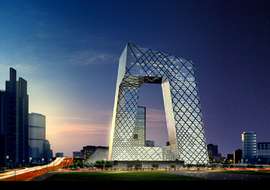 Rem seems to have a fine model going — mixing research, theory, and practice. But to design the center for state television in China? The chief propaganda outlet in a country that heavily censors its media? And imprisons and tortures its people for speaking out?
Rem seems to have a fine model going — mixing research, theory, and practice. But to design the center for state television in China? The chief propaganda outlet in a country that heavily censors its media? And imprisons and tortures its people for speaking out?
It sounds more like opportunism than constructive engagement.
Beijing is one of the densest cities in the world, and hundreds of thousands of people are being forcibly evicted from their homes to make way for new construction — much of it related to the 2008 Olympics. Developers literally send gangs of thugs into old neighborhoods to beat up elderly people and get them out. Risking arrest and prison, thousands of evicted families are protesting how they can: petitioning government officials, posting anonymously on the Internet, and in a last desperate effort, even setting themselves on fire in Tiananmen Square.
But Rem is not alone. Big name architects like Raimund Abraham, Zaha Hadid, Paul Andreu, Norman Foster, Michael Graves, Jacques Herzog and Pierre de Meuron are also taking advantage of China’s construction boom.
Like much of the party leadership in the former Soviet Union, much of China’s ruling elite have a background in engineering, giving extra caché to massive projects like the three gorges dam and the space program.
From Time Magazine, May 2004:
“Detractors cite the $730 million CCTV project as the ultimate example of the Chinese regime’s tendency to plunder state coffers to glorify its own iron authority and say Koolhaas is an opportunist taking advantage of the country’s unique combination of state power and state capital to realize his own artistic ambitions. Ian Buruma, a writer who is a friend of Koolhaas, wondered aloud in the Guardian, a British newspaper, how the world would have reacted if an architect of Koolhaas’ stature had in the 1970s designed a TV station for Chilean dictator Augusto Pinochet.
But Koolhaas, 59, who was one of the first Western architects to study and write about China’s urban explosion, revels in such intellectual tussles. CCTV, he insists, like the mainland itself, ‘is in mutation’ and the building represents an effort to complement the state-owned company’s desire to keep pace with the times. CCTV’s current headquarters is completely closed to the public. Koolhaas’ design, in contrast, includes a public ‘media park’ in and around the base of the building intended to foster more interaction between commissars and the masses. ‘We are engaged,’ he says, ‘with an effort to support within [China’s] current situation the forces that we think are progressive and well-intentioned... We’ve given them a building that will allow them to mutate.’”
Indeed, how people do mutate.
Orientation
From Beyond Vietnam: A Time to Break Silence:
“In 1957 a sensitive American official overseas said that it seemed to him that our nation was on the wrong side of a world revolution. During the past ten years we have seen emerge a pattern of suppression which now has justified the presence of U.S. military ‘advisors’ in Venezuela. This need to maintain social stability for our investments accounts for the counter-revolutionary action of American forces in Guatemala. It tells why American helicopters are being used against guerrillas in Colombia and why American napalm and green beret forces have already been active against rebels in Peru. It is with such activity in mind that the words of the late John F. Kennedy come back to haunt us. Five years ago he said, ‘Those who make peaceful revolution impossible will make violent revolution inevitable.’
Increasingly, by choice or by accident, this is the role our nation has taken — the role of those who make peaceful revolution impossible by refusing to give up the privileges and the pleasures that come from the immense profits of overseas investment.
I am convinced that if we are to get on the right side of the world revolution, we as a nation must undergo a radical revolution of values. We must rapidly begin the shift from a ‘thing-oriented’ society to a ‘person-oriented’ society. When machines and computers, profit motives and property rights are considered more important than people, the giant triplets of racism, materialism, and militarism are incapable of being conquered.
A true revolution of values will soon cause us to question the fairness and justice of many of our past and present policies. On the one hand we are called to play the good Samaritan on life’s roadside; but that will be only an initial act. One day we must come to see that the whole Jericho road must be transformed so that men and women will not be constantly beaten and robbed as they make their journey on life’s highway. True compassion is more than flinging a coin to a beggar; it is not haphazard and superficial. It comes to see that an edifice which produces beggars needs restructuring. A true revolution of values will soon look uneasily on the glaring contrast of poverty and wealth. With righteous indignation, it will look across the seas and see individual capitalists of the West investing huge sums of money in Asia, Africa and South America, only to take the profits out with no concern for the social betterment of the countries, and say: ‘This is not just.’ It will look at our alliance with the landed gentry of Latin America and say: ‘This is not just.’ The Western arrogance of feeling that it has everything to teach others and nothing to learn from them is not just. A true revolution of values will lay hands on the world order and say of war: ‘This way of settling differences is not just.’ This business of burning human beings with napalm, of filling our nation’s homes with orphans and widows, of injecting poisonous drugs of hate into veins of people normally humane, of sending men home from dark and bloody battlefields physically handicapped and psychologically deranged, cannot be reconciled with wisdom, justice and love. A nation that continues year after year to spend more money on military defense than on programs of social uplift is approaching spiritual death.
This kind of positive revolution of values is our best defense against communism. War is not the answer. Communism will never be defeated by the use of atomic bombs or nuclear weapons. Let us not join those who shout war and through their misguided passions urge the United States to relinquish its participation in the United Nations. These are days which demand wise restraint and calm reasonableness. We must not call everyone a Communist or an appeaser who advocates the seating of Red China in the United Nations and who recognizes that hate and hysteria are not the final answers to the problem of these turbulent days. We must not engage in a negative anti-communism, but rather in a positive thrust for democracy, realizing that our greatest defense against communism is to take offensive action in behalf of justice. We must with positive action seek to remove those conditions of poverty, insecurity and injustice which are the fertile soil in which the seed of communism grows and develops.”
— Dr. Martin Luther King, Jr., April 4, 1967.
Search and replace “napalm” with “depleted uranium”, “Communism” with “terrorism”, “the seating of Red China in the United Nations” with “withdrawing from Iraq.”



